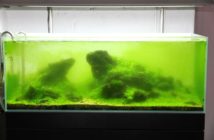Last September the Texas Gulf Coast was hammered by Hurricane Ike, the third most destructive hurricane to every hit the United States (according to Wikipedia). This vicious storm took a tremendous toll on aquarium keepers all over southeast Texas and Louisiana…and not just in the immediate gulf region. Aquarium keepers all over the state lost entire aquariums because of this storm, and most of the people who lost all, or at least some of their livestock could never have prepared for the devastation. No amount of precaution or planning could have prevented homes from being washed away and nobody is setup to last weeks, or even months, without power. Some reefkeepers had to evacuate and couldn’t take their setups with them and there wasn’t enough time to move livestock to tanks in safer areas due to the hurricane’s path prediction always changing. But not every problem was unavoidable.
Many aquarists lost livestock due to poor planning and simply doing the wrong things. Some who were only out of power for a couple days wound up breaking down their entire setups because their direct actions caused aquarium meltdowns and massive die-off. I was extremely fortunate with this storm. I didn’t lose a single fish and my rose bubble tip anemone (Entacmaea quadricolor) even split…although anemones split due to stress, but I won’t complain. In talking with other aquarium keepers, and relying on my own experiences, I have created a list of what to do and what not to do.
-First of all, you are more important than your aquarium. Your tank and livestock can be replaced. So don’t risk your or your family’s life to protect your tank and/or man the generator.
-Before we get too far into hurricane season, contact your insurance company and double check to see if your aquarium and livestock are covered under your current homeowner’s policy. Some people I talked to were completely covered while others were laughed at. It doesn’t hurt to ask in advance and even adjust your policy to cover your aquarium.
-Be prepared! Plan for every situation. Plan for power outages, rising water, flying debris (can come through a window and strike a nearby aquarium), electrical surges that can ruin equipment, and the possibility of going a very long time without any power. Always have an out in case of any unforeseen occurrence.
-If you get into a bind, ask for help. Fellow hobbyists are usually more than willing to lend a hand. Don’t let pride or anything else get in the way of protecting your livestock.
-A generator goes a really long way. When the power is out for more than a few hours, your tank’s stability starts going downhill. Ammonia starts building up and oxygen levels and pH both drop. So, get a generator and fire it up. Plug in the essentials and save your tank from utter disaster. I’ll tell you what to power and what to leave off in a moment.
-While the generator is vastly important, you can’t power anything without gas. And as most of us experienced with this, and every other hurricane, gas is so hard to come by. I know that in my part of town, the gas stations were completely sucked dry and remained that way for several days. So, make sure that you have plenty of gas on hand. Some have even gone as far as to stockpile enough gas to power a generator nonstop for weeks. If a hurricane didn’t pop up, they would simply fill their vehicles with the gas and refill their gas cans with a fresh supply.
-Once you get your generator up and running, only power the return pump or powerheads. Do not power your tank’s lights or calcium reactor, or anything like that. The powerheads, return pump, and even the protein skimmer should be the only things you power via the generator. These will all, in their own ways, increase the oxygen levels in the tank and stabilize your pH in the process. You can kick on the lights every once in a while, but do so only for a short period of time as they use up a lot of energy.
-Keep the generator outdoors and away from open windows. Carbon monoxide from the exhaust can kill. Also, chain your generator up and keep it out of site. Many desperate folks may see it and decided they need it more than you do.
-Please keep in mind that some aquarium equipment can be damaged by a generator. I’m not 100% sure on why or how, but a guy I know fried all of his powerheads due to an issue with his generator. I think the issue has to do with electrical current, but again, I’m not entirely sure. I do know however that you can purchase a cheap device to put on the output side of your generator to fix this problem.
-If you cannot afford a generator, or if your tank is too small to justify a new generator purchase, you can use airstone bubblers. These are battery operated air pumps that are used in bait buckets and can easily be found at any sporting goods store or bait shop. They are cheap, easily replaceable, and the battery life can last for several hours nonstop.
-Another power source that is frequently overlooked is your car or a car battery. Your car is essentially a generator on wheels. Just buy an inverter and run an extension cord from you car to your tank. But, make sure your car is nearby and within site at all times as a running car can be easily stolen.
-Do not feed your fish! I know it is very tempting to feed your fish and corals during the multi-day power outage, but don’t. The fish will be fine for several days without food, and feeding the tank will most certainly lead to a devastating ammonia spike.
-Heat can become a major issue as well, especially if the hurricane were to hit during the warmer months. But do not fret. There are some solutions to this. First of all, the tank temp won’t get all that hot, unless it is in or near a window. Additionally, any surface agitation caused by the powerheads or bubblers you should be running will cause some evaporation which will help keep the tank cool. But if your tank’s temperature is just too high, you have a couple options. My first choice would be to place a small fan somewhere where it will blow across the surface of the water. Then just plug it into the generator and let it run for a little while, turning if off every few hours to conserve gas. The other option is to use ice in some way. I highly recommend against this, but it can be done if careful enough. Simply place ice in plastic bags and float them in your tank. Or, if you have a canister filter, fill a 5-gallon bucket with ice and put the canister filter in the bucket (surrounded by ice of course).
-Help out your fellow hobbyists. If your situation improves (or never got bad in the first place) lend a helping hand to those in need. If you have a generator, let someone borrow it. If someone needs a babysitter, offer a hand. Oftentimes a grateful reefkeeper will let you keep a frag, or even all of the livestock if they cannot get back on their feet. But don’t expect it, and make sure to offer the owner back all of his or her livestock and do not ask for anything in return. It’s the right thing to do and your kindness will certainly be rewarded sooner or later.
-If you do help your hobbyists, be sure to protect yourself. If you get any corals from someone, make sure to dip them in a pest killing solution like Lugol’s Iodine, or Tropic Marine Pro Coral Cure (TMPCC) or something similar. If you don’t, you open yourself up to a pest infestation.
-And whenever the power is restored, take one final precaution. If you had water anywhere in your system that sat stagnant for any length of time, throw it out! Water trapped in overflows, canister filters, and sumps can become toxic to your already stressed livestock if it has sat motionless for any length of time. Harmful nutrients like ammonia and nitrite can build up quickly, and when the power comes back on and the return pump kicks in, your tank will be inundated with harmful toxins. So, just remove that old stagnant water and do a water change. Chances are you were due for one anyways.
I hope this helps everyone. If you have any questions be sure to email us at info@aquanerd.com and we’ll gladly discuss these thing with you.






Pingback: Surviving the Blizards | AquaNerd()